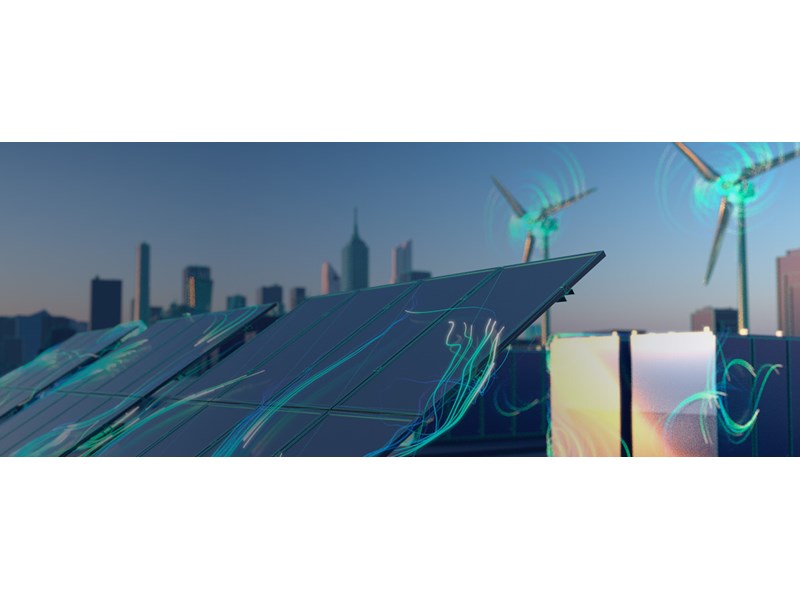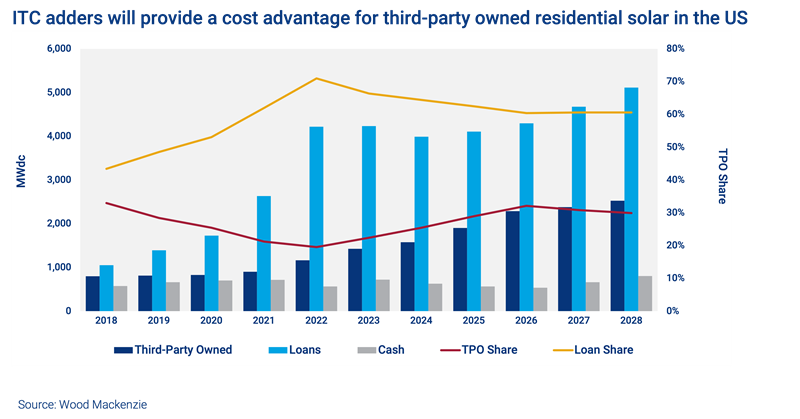A new era for US residential solar finance
Investment tax credit (ITC) adders and loan market headwinds are shaking up the US residential solar financing landscape
3 minute read
Zoë Gaston
Principal Analyst, US Distributed Solar

Zoë Gaston
Principal Analyst, US Distributed Solar
Zoë's areas of focus include residential solar policy and project finance
Latest articles by Zoë
-
Opinion
The US solar industry faces a perfect storm of Federal policy and trade challenges
-
Opinion
Insights from Wood Mackenzie’s Solar & Energy Storage Summit 2025
-
Opinion
US residential solar turbulence persisted through 2024
-
Opinion
Solar surge: the US solar industry shatters records in 2024
-
Opinion
US residential solar market turmoil reached new heights this year
-
Opinion
RE+ 2024: Our 7 biggest takeaways
Last year was a record-breaking but chaotic year for the residential solar industry. The market installed 1,687 MWdc in Q4 to reach 5.9 GWdc of annual installed capacity, a remarkable 40% increase over 2021. The loan market continued its dominance of the past five years, achieving its largest volume of installed capacity. However, the segment faces challenges with interest rate increases and bank turmoil.
Since the passage of the Inflation Reduction Act (IRA), there has also been more enthusiasm for the future growth of the third-party ownership (TPO) segment. TPO systems are eligible for the ITC adders while customer-owned systems are not. Continued loan market headwinds and the TPO ITC adder pricing advantage will lead to a shift in the residential solar financing environment starting this year.
Wood Mackenzie’s US residential solar finance update H1 2023 delves into the state of residential solar consumer finance in the US. The report highlights trends and forecasts of the third-party ownership (leases and power purchase agreements) and customer ownership (cash and loan purchases) markets.
Fill in the form to access a complimentary extract and read on for some key highlights.
GoodLeap continues its reign as leading financier
The top five players financed 71% of the entire residential market in 2022, similar to 2021. GoodLeap grew by 40% last year to capture 26% of the overall residential solar market and 36% of the loan market in 2022. Sunrun and Sunnova again dominated the TPO market, together capturing a 79% share.
Overall, many financiers funded record volumes in 2022, which drove the residential solar market to new levels last year.
For the first time since 2014, the TPO segment is outpacing customer ownership
Wood Mackenzie expects that the TPO segment will grow by 23% while the customer-ownership segment will grow by 4% in 2023. Recent banking turmoil will impact both segments this year, resulting in increased financing costs and tighter credit standards. Interest rate increases will also continue to impact both segments but will negatively affect loans more than the TPO segment.
Loans have more interest rate sensitivity than TPO products. This is primarily driven by the typical financing make-up of the products – debt for loans versus a portion of debt and equity for TPO. Further, customers make fewer unscheduled principal loan prepayments in an inflationary environment, which increases the cost of loans and decreases returns for loan providers.
After reaching its highest annual market share of 70% in 2022, the loan market will lose share for the first time since 2016. In contrast, the TPO market will start to win back share in 2023 as financiers begin to qualify systems for the ITC adders and partner with more installers to offer TPO products. After hitting its lowest annual share in 2022, we expect that the segment will record its highest volume of installed capacity in 2023.
California NEM 3.0 will impact both solar financing segments in 2024, but TPO is more resilient
The residential solar market will contract by 3% in 2024, the first full year impacted by California NEM 3.0. However, the TPO segment will continue to benefit from the ITC adders and gain share, growing by 10% in 2024 and an average rate of 20% in 2025 and 2026.
Storage offerings and expertise will become more vital to success in California under the new net billing regime. Major TPO providers continue to expand storage products nationwide and will capitalize on this shift in California.
The customer-owned market will contract by 7% in 2024 as loan providers struggle to regain footing from interest rate headwinds and the implementation of California NEM 3.0. The segment will begin to recover in 2025 but will grow slower than the overall residential solar market in 2025 and 2026.
US residential solar asset-backed securitizations (ABS) and solar loan credit performance have seen a decline
ABS transactions totaled US$3.89 billion in 2022 and averaged US$324 million per transaction size. This is a slight decrease compared to the 2021 total, but a year-over-year increase in average transaction size.
There has also been a rise in delinquency and loss rates, coupled with a significant drop in solar loan prepayments. This can be attributed to rising interest rates and inflation, among other factors, and will contribute to a slowdown in the loan market this year.
Get a closer look at our US residential solar finance update
Fill in the form at the top of the page for a complimentary extract.








